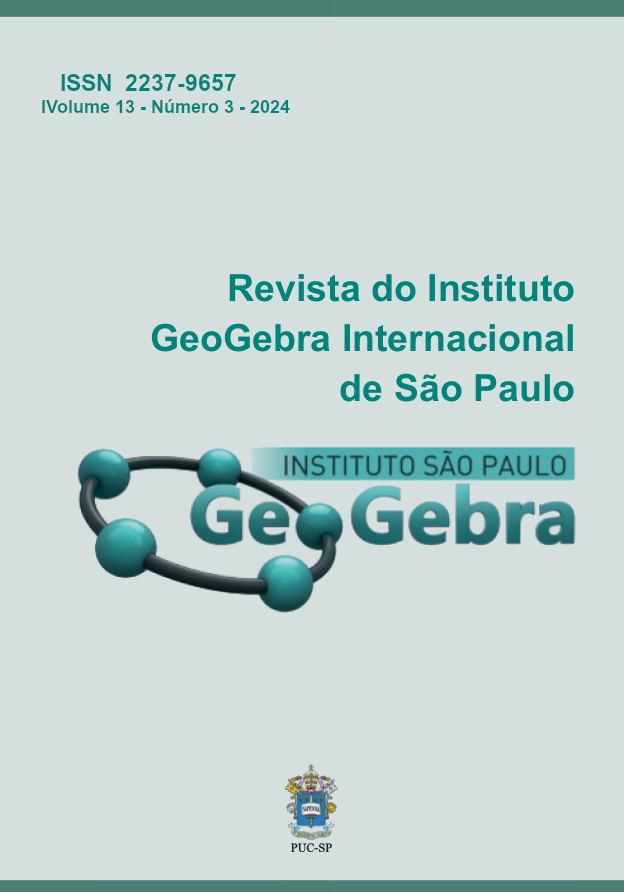History of Mathematics and Technology: visualization of recurring sequences and the notion of 2D/3D board
DOI:
https://doi.org/10.23925/2237-9657.2024.v13i3p045-064Keywords:
History of Mathematics, Numerical sequence, Mathematics TeacherAbstract
The study of recurring numerical sequences usually presents little space for discussion in the context of History of Mathematics books in Brazil. In the context of Mathematics teacher training, research into mathematical concepts related to different forms of representation of recurring numerical sequences acquires strategic importance. Thus, the present work presents geometric properties related to the notion of Board, which is closely related to the notion of numerical sequence. Furthermore, visualization using the GeoGebra software allows you to explore some examples of 2D/3D Boards related to the Padovan, Pell and Mersenne numerical sequences, in addition to enabling the construction of a different learning scenario for the Mathematics teacher.
References
ALVES, F. R. V. Fórmula De Moivre, ou de Binet ou de Lamé: demonstrações e generalidades sobre a sequência generalizada de Fibonacci - SGF. Revista Brasileira de História da Matemática, v. 17, n. 33, p. 1-16, 2017. https://doi.org/10.47976/RBHM2017v17n3301-16
ALVES, F. R. V.; CATARINO, P. M. C. Sequência de Padovan ou Coordonier, Revista Brasileira de História da Matemática, v. 22, nº 45, 1 – 23 2022.
ALVES, F. R. V. Propriedades Combinatórias sobre a sequência de Jacobsthal, a noção de tabuleiro e alguns apontamentos históricos. Revista Cearense de Educação Matemática, v. 1, n. 1, p. 1-13, 2022. https://doi.org/10.56938/rceem.v1i1.3146
ALVES, F. R. V. História da Matemática: os números figurados 2D/3D. Revista CONEXÕES, CIÊNCIA e TECNOLOGIA, v. 6, nº 2, 1 – 20, 2012.
ALVES, F. R. V.; CATARINO, P. M. C ; VIEIRA, R. P. M; SPREAFICO, E, V. P. . Combinatorial approach on the recurrence sequences: An evolutionary historical discussion about numerical sequences and the notion of the board. International Electronic Journal of Mathematics Education, v. 19, p. em0775-16, 2024.
ALVES, F. R. V.; SOUSA, R. T. Some elementary combinatory properties and Fibonacci numbers. Journal of Instructional Mathematics, v. 4, n. 1, p. 1-16, 2023. https://doi.org/10.37640/jim.v4i1.1756
ALVES, F. R. V.; VIEIRA, R. P.; CATARINO, P. M. C. A note on Telephone Numbers, Notes on Number Theory and Discrete Mathematics, v. 23, n. 1, p. 195-203, 2023. https://doi.org/10.7546/nntdm.2023.29.2.195-203
BARROS, F. E.; ALVES, F. R. V; CATARINO, P. M. M. C.; SOUSA, R. T.. The construction of figured numbers in GeoGebra software using algebraic properties. The Montana Math Enthusiast, v. 21, n. 1, p. 203-224, 2024. https://doi.org/10.54870/1551-3440.1624
BENJAMIN, A. T.; QUINN, J. J. The Fibonacci numbers: exposed more discretely. Mathematics Magazine, v. 76, n. 3, p. 182-192, 2003a. https://doi.org/10.2307/3219319
BENJAMIN, A. T; QUINN, J. J. Proofs that really count: the art of combinatorial proof., Washington, DC: Mathematical Association of America. (Dolciani mathematical expositions, n. 27, 2003b.
BENJAMIN, A. T.; QUINN, J. J. Recounting Fibonacci and Lucas Identities. The College Mathematics Journal, v. 30, n. 5, p. 359-366, 1999. https://doi.org/10.2307/2687539
BENJAMIN, A. T.; PLOTT, S. S.; SELLERS, J. A. Tiling proofs of recent sum identities involving Pell numbers, Annals of Combinatorics, v. 12, n. 3, p. 271-278, 2008. https://doi.org/10.1007/s00026-008-0350-5
BENJAMIN, A. T.; WALTON, D. Counting on Chebyshev polynomials. Mathematics Magazine, v. 82, n. 2, p. 117-126, 2009. https://www.jstor.org/stable/27765885
BURTON, D. M. The history of mathematics: an introduction. 6th ed. New York: McGraw-Hill, 2007.
DOŠLIĆ, T.; PODRUG, L. Tilings of a Honeycomb Strip and Higher Order Fibonacci Numbers, AirXiv, v. 25, n. 2, p. 1-22, 2022. https://doi.org/10.48550/arXiv.2203.11761
DRESDEN, G.; TULSKIKH, M. Tiling a (2 × n)-Board with Dominos and L-Shaped Trominos, J. Integer Seq., v. 24, 2021. https://cs.uwaterloo.ca/journals/JIS/VOL24/Dresden2/dresden9.pdf
ESTRADA, M. F. et al. História da Matemática. Lisboa: Universidade Aberta, 2000.
EVES, H. An introduction to the History of Mathematics. 3. ed. Chicago: Holt, Reinhardt and Wilson ltd, 1969.
KATZ, V. A History of Mathematics. New York: Addison Wesley, 1998.
KOSHY, T. Fibonacci and Lucas numbers with applications. 2nd ed. Hoboken: Wiley & Sons. v. 2, 2019.
KOSHY, T. Pell and Pell-Lucas numbers with applications. New York: Springer, 2014.
KOSHY, T. Fibonacci and Lucas numbers with applications. New York: Wiley, 2001.
MONTEIRO, A. C. A. et al. Engenharia didática para o ensino de sequência recursiva: o caso da sequência de Fibonacci. Revista Contribuiciones a las cienccia sociales, v. 16, nº 1, 1 – 14, 2023.
STILLWELL. J. Mathematics and its history. New York: Springer, 2010.
TEDFORD, S. J. Combinatorial identities for the Padovan Numbers, Fibonacci Quarterly, v. 57, n. 4, p. 291-298, 2019.
VIEIRA, R. P.; ALVES, F. R. V.; CATARINO, P. M. C. Combinatorial Interpretation of Numbers in the Generalized Padovan Sequence and Some of Its Extensions. Axioms, v. 11, n. 11, p. 1- 9, 2023. https://doi.org/10.3390/axioms11110598
VIEIRA, R. P. M. Investigação da Complexificação, Generalização e Modelo Combinatório dos Números de Padovan e Perrin com a Engenharia Didática. Tese (Doutorado em Ensino de Ciência e Matemática). Programa de Pós-graduação em Rede Nordeste de Ensino. 2024, 466f.
ZIQIAN, J; DRESDEN, G. Tetranacci Identities via Hexagonal Tilings, Fibonacci Quarterly, v. 60, n. 2, p. 99-103, 2022.
Downloads
Published
How to Cite
Issue
Section
License
Copyright (c) 2024 Journal of the GeoGebra International Institute of São Paulo

This work is licensed under a Creative Commons Attribution 4.0 International License.
Submission, processing, and publication of articles sent to the journal and registration of the DOI at Crossref is free of charge.
Authors retain their copyright and grant the journal the right of first publication of their article, which is simultaneously licensed under a Creative Commons - Attribution 4.0 International license CC BY that allows others to share the article by acknowledging its authorship and initial publication by the journal.
The GeoGebra journal encourages its authors to register their work with information and communication management systems aimed at researchers, such as Academia.edu, Mendeley, ResearchGate, etc.


 10.23925
10.23925
